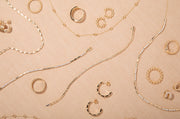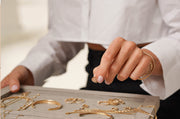The concept and song lyric, “a diamond is forever,” presumably refers to a diamond’s endless value and beauty through time. It also seems to encompass the complete journey of a natural diamond, the very important “before.” Keep in mind that these magnificent stones rose from way below the Earth's surface billions of years ago. Natural diamonds come from the depths of darkness and bring so much light and joy above ground. An interesting aspect of the diamond world that has emerged through time as technology has advanced, is the collision between what is real (from nature) and an illusion (what man has created). We now live in a world where creating an object that looks like a diamond is pretty amazing. It’s easy to buy something that looks almost exactly like a diamond but is very much not real.
Let’s explore how to verify the authenticity of a genuine diamond with expert tips to ensure that you're getting a real, natural diamond.
Professional Verification
Most diamonds today come with grading reports which will distinguish between a naturally mined diamond and a lab grown diamond. The most solid and accurate reports come from the Gemological Institute of America [GIA].
It’s best to rely on professional grading services, like GIA, in order to determine a diamond's authenticity and whether it is real or not.
Further, transacting with reputable and trusted sources, like our diamond experts at DRD, will ensure that you are getting what you pay for in terms of genuine, natural diamonds.
Tips for Buying Authentic Diamonds
DRD has a strict and official Commitment to Authenticity. Their specialists will guide you through the buying process with full transparency and will thoroughly answer every question along the way.
Every DRD diamond comes with a GIA report, so you can be sure that what you're taking home is authentic.
Lab Grown vs Natural Diamonds
Is there a difference between lab grown vs natural diamond? Natural diamonds are naturally occurring and carbon-based, formed over billions of years deep within the Earth. In contrast, lab grown diamonds (or synthetic diamonds) are created in controlled environments using advanced technology, mimicking the natural diamond formation process but in a significantly shorter timeframe. Lab grown diamonds possess the same chemical, physical, optical, and structural properties as natural diamonds, making them visually identical to the naked eye.
While natural diamonds derive their uniqueness from the prolonged and natural formation process, resulting in rare inclusions and characteristics, lab grown diamonds are produced with fewer impurities, often resulting in higher clarity. The key difference lies in their origin: a lab grown diamond is made in a lab setting, whereas a natural diamond forms naturally over millions of years. Both types of diamonds are real diamonds, but their different formation processes can influence their market value and consumer perception.
Moissanite, a diamond simulant, is also lab-created but differs significantly from diamonds in composition. It is silicon carbide-based and has a higher refractive index, causing it to sparkle more like a rainbow compared to the classic brilliance of an authentic diamond. Understanding these distinctions is crucial for making an informed purchase, whether you're considering a diamond engagement ring, diamond earrings, or other diamond jewelry.
Cost Comparison
Lab grown diamonds and other diamond alternatives can cost up to 90% less than their natural diamond counterparts. This is an important fact as you want to make sure that you’re being charged for a lab grown diamond and not someone trying to charge natural diamond prices while providing a diamond that was created in a lab.
Natural diamonds - while significantly more expensive - hold their value over time.
The Water Test
The water test is a hack to tell if a diamond is real or not.
First, fill a glass with water. Place the diamond in the water. If the diamond sinks to the bottom of the glass, it’s likely real. However, it's best to have the diamond sent out for official grading to truly determine if it's real or not.
The Fog Test
If you breathe on a diamond, the fog should dissipate almost immediately if it's a real stone. While the fog test is a handy preliminary check, it's not always accurate.What to Look for in Diamond Certification
The first thing to look for are the grading results. All DRD diamonds are from the Gemological Institute of America [GIA]. Every GIA certified diamond has a number on the report that is also laser inscribed on the diamond. The diamond certification should provide information on the 4 C's (carat weight, cut, color and clarity) of the diamond.The report should also include the diamond proportions, measurements and other characteristics such as the polish, symmetry and fluorescence grade.
There will also be an inclusion plot that shows the internal and external characteristics.
Checking for Imperfections and Inclusions
The majority of real, natural diamonds will have some degree of imperfection or inclusions either on the surface or internally. Inclusions, often unfairly called "flaws'' or "imperfections," are unique characteristics that give each diamond its distinct identity, much like a personal fingerprint. You can check for these by looking at a diamond through a jeweler's loupe which will provide 10x magnification.The Loupe Test
A loupe can be used to evaluate the quality and authenticity of a diamond. Of course you can use the loupe to look for inclusions/imperfections or assess the cut of the diamond, however, it's best to use the loupe to look for an inscription to determine the authenticity.Based on the appearance, a lab grown diamond will look the same as a natural diamond. If you begin your diamond research/buying process well informed about the differences and necessary certifications, you’ll be in great shape. It’s all about asking the right questions!
The DRD team of GIA certified specialists are always available to answer any questions and walk you through options in order to make the best choice. The DRD team is dedicated to supporting clients throughout the entire process because buying a diamond is very exciting AND a big deal! Knowledge is power here - accurate information and guidance leads to a diamond that you’ll love and feel great about forever!





